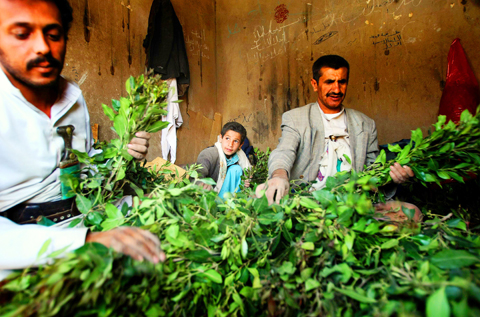For Yemenis, the mild narcotic qat is as much a part of the social fabric as an after-dinner drink in the West and, as with brandies, connoisseurs want the best varieties. But the trees that produce the most sought-after leaves now lie in a war zone.
Mohammed Ahmed Ghanem runs a stall selling qat in the Yemeni capital.
Prices for an afternoon’s worth of the stimulant leaves can run anywhere between US$2 and US$100 depending on quality.

PHOTO: AFP
But the very best, known as Shami, is no longer available, Ghanem acknowledges ruefully.
The escalation since August of the Yemeni government’s conflict with Shiite rebels in the mountains of the far north mean that growers can no longer get their produce to market in Sanaa.
Shami is one of a number of varieties of qat cultivated with a view to satisfying the leisured elite of what is one of the world’s poorest countries.
“If I didn’t use qat, I’d be cut off from all my friends and relatives,” one well-to-do user said as he lounged on cushions in a Sanaa salon, his cheeks bulging with a wadful of leaves.
Qat is legal in Yemen, but like many better-off users he did not want his name used in print.
In neighboring Saudi Arabia, as in the US and some European countries, the drug is banned. And even in Yemen, the authorities have tried — with limited success — to restrict its use in government offices.
“I know all about the economic and social costs but I can’t live without it,” the user said.
Every day, he knocks off work around noon to buy his day’s supply. It is the bitter juice of the leaves that users extract through prolonged mastication, so it is important that they be as fresh as possible.
He then changes out of his Western-style suit into traditional Yemeni cloak, belt and dagger and heads down to the salon.
“It’s the best moment of the day,” he said.
For Yemeni men, the qat session is an opportunity to cement social ties, to debate issues of the day, to put the world to right. But increasing numbers of women and teenagers indulge in the habit too.
Sales of qat in Yemen are estimated to run to US$800 million a year, a huge sum in a country with GDP per head of less than US$1,000.
Qat can earn farmers three times the revenue of any other crop but irrigating it takes a huge toll on the country’s aquifers, with 85 percent of the country’s wells used for qat cultivation.

Former Nicaraguan president Violeta Chamorro, who brought peace to Nicaragua after years of war and was the first woman elected president in the Americas, died on Saturday at the age of 95, her family said. Chamorro, who ruled the poor Central American country from 1990 to 1997, “died in peace, surrounded by the affection and love of her children,” said a statement issued by her four children. As president, Chamorro ended a civil war that had raged for much of the 1980s as US-backed rebels known as the “Contras” fought the leftist Sandinista government. That conflict made Nicaragua one of

COMPETITION: The US and Russia make up about 90 percent of the world stockpile and are adding new versions, while China’s nuclear force is steadily rising, SIPRI said Most of the world’s nuclear-armed states continued to modernize their arsenals last year, setting the stage for a new nuclear arms race, the Stockholm International Peace Research Institute (SIPRI) said yesterday. Nuclear powers including the US and Russia — which account for about 90 percent of the world’s stockpile — had spent time last year “upgrading existing weapons and adding newer versions,” researchers said. Since the end of the Cold War, old warheads have generally been dismantled quicker than new ones have been deployed, resulting in a decrease in the overall number of warheads. However, SIPRI said that the trend was likely

NUCLEAR WARNING: Elites are carelessly fomenting fear and tensions between nuclear powers, perhaps because they have access to shelters, Tulsi Gabbard said After a trip to Hiroshima, US Director of National Intelligence Tulsi Gabbard on Tuesday warned that “warmongers” were pushing the world to the brink of nuclear war. Gabbard did not specify her concerns. Gabbard posted on social media a video of grisly footage from the world’s first nuclear attack and of her staring reflectively at the Hiroshima Peace Memorial. On Aug. 6, 1945, the US obliterated Hiroshima, killing 140,000 people in the explosion and by the end of the year from the uranium bomb’s effects. Three days later, a US plane dropped a plutonium bomb on Nagasaki, leaving abut 74,000 people dead by the

Indian Prime Minister Narendra Modi is to visit Canada next week, his first since relations plummeted after the assassination of a Canadian Sikh separatist in Vancouver, triggering diplomatic expulsions and hitting trade. Analysts hope it is a step toward repairing ties that soured in 2023, after then-Canadian prime minister Justin Trudeau pointed the finger at New Delhi’s involvement in murdering Hardeep Singh Nijjar, claims India furiously denied. An invitation extended by new Canadian Prime Minister Mark Carney to Modi to attend the G7 leaders summit in Canada offers a chance to “reset” relations, former Indian diplomat Harsh Vardhan Shringla said. “This is a